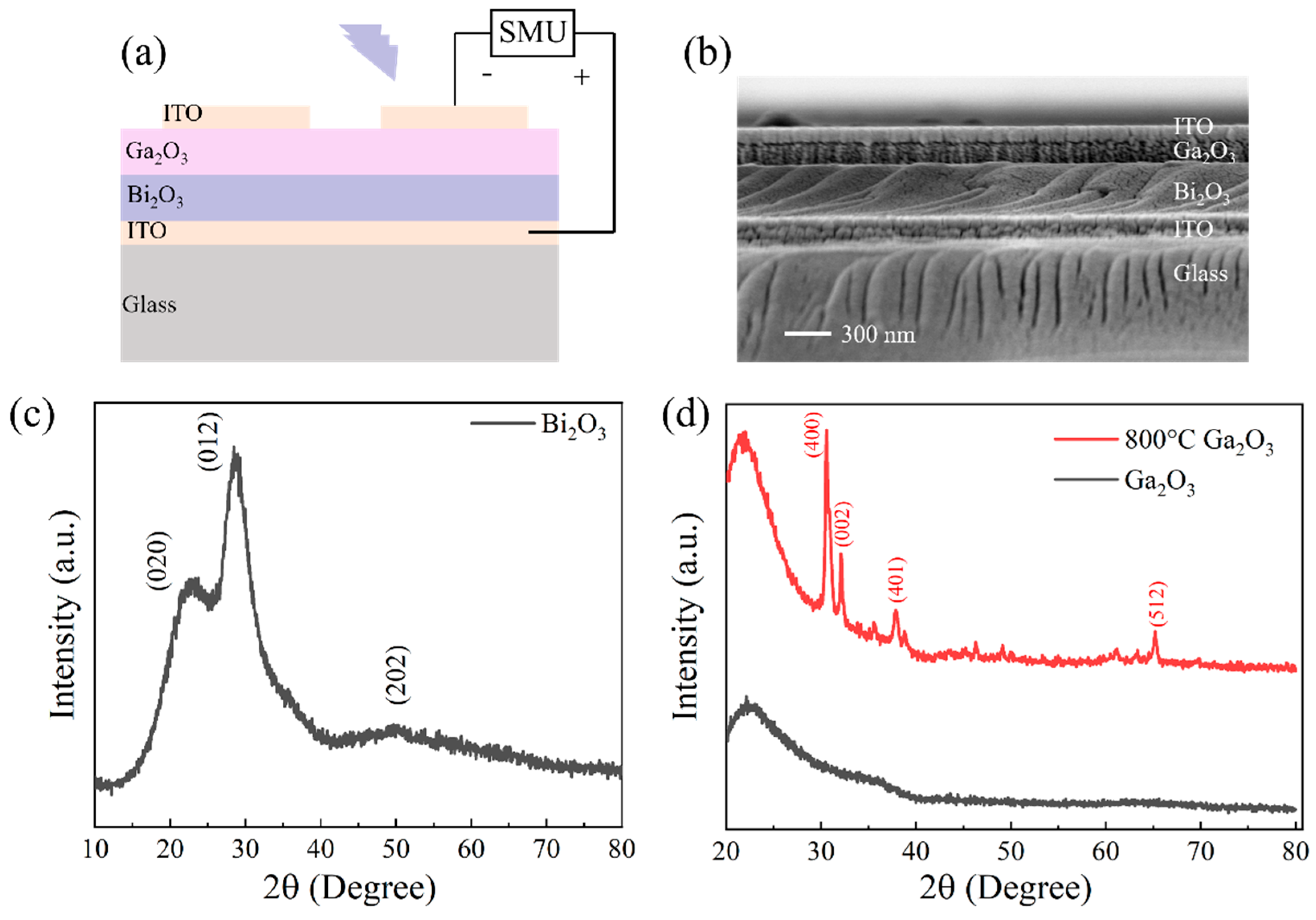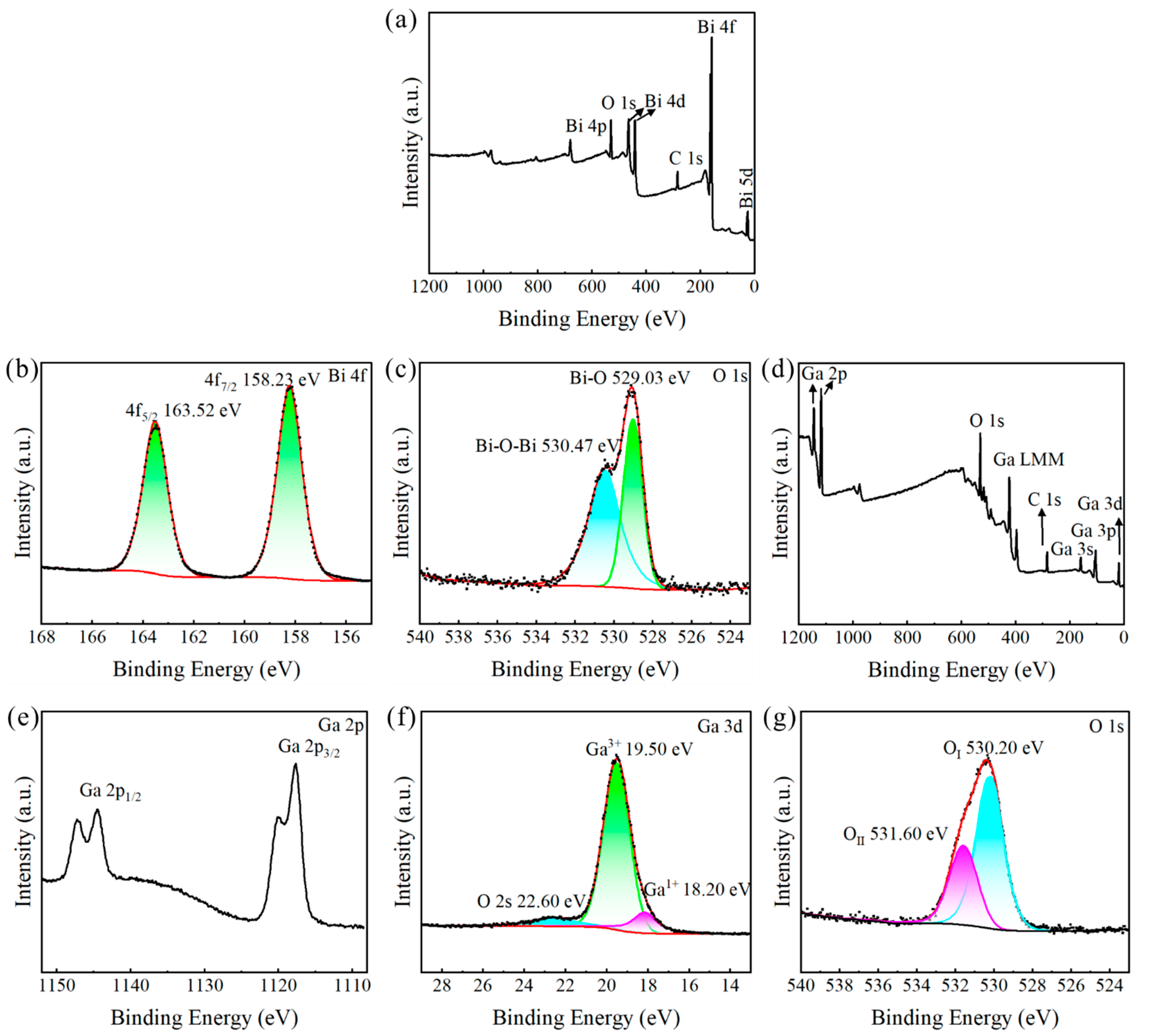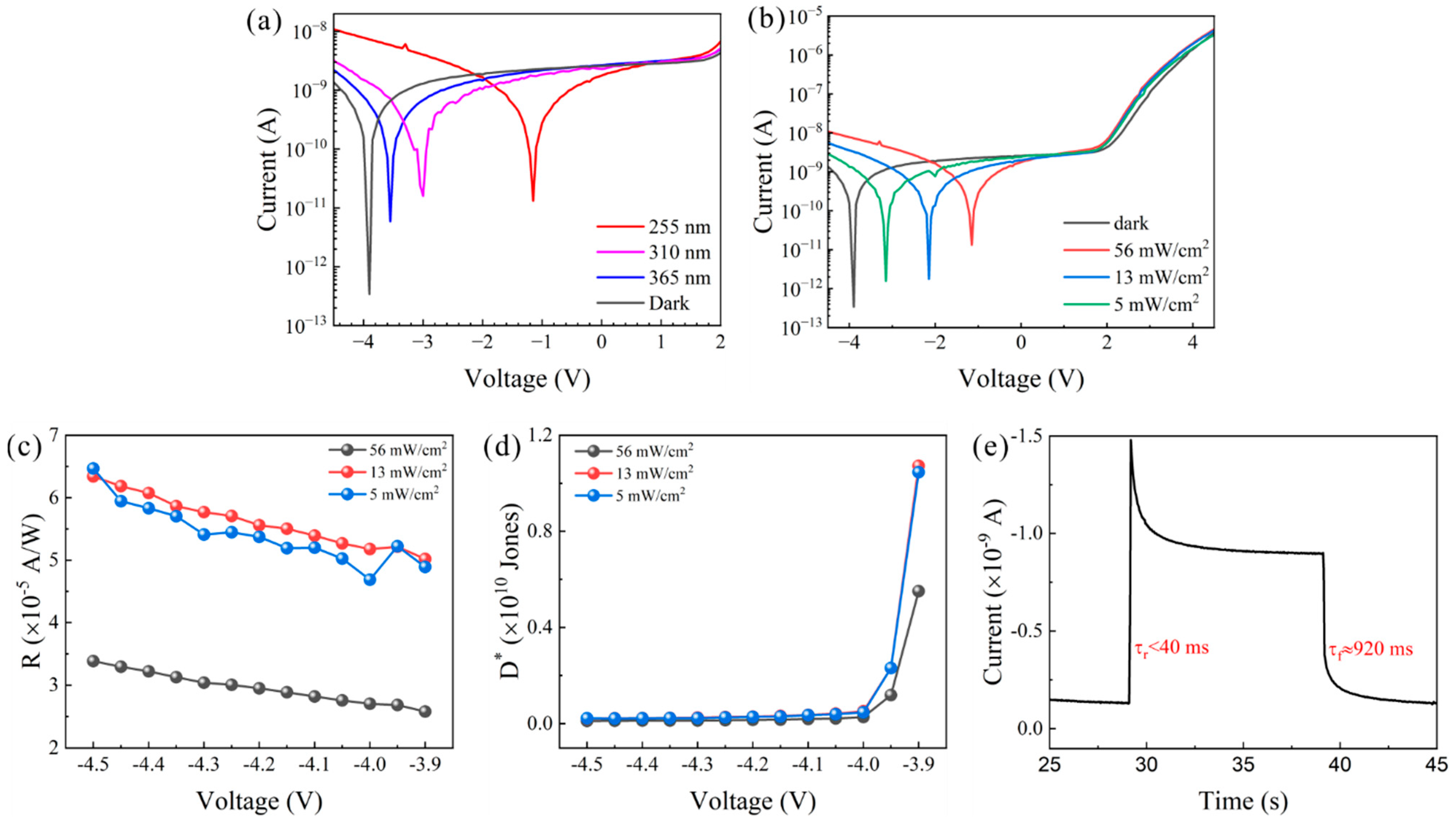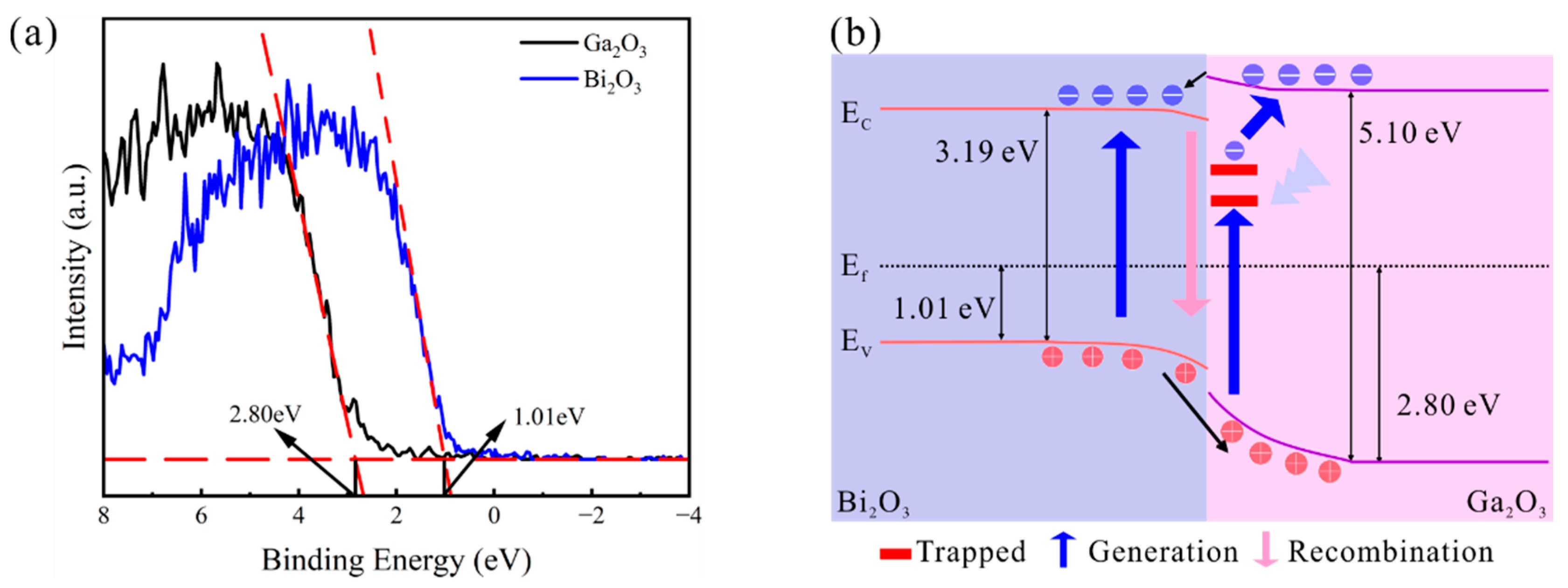Fabrication and Ultraviolet Response Characteristics of All-Oxide Bi2O3/Ga2O3 Heterojunction
Abstract
1. Introduction
2. Experimental Procedure
3. Results and Discussion
4. Conclusions
Author Contributions
Funding
Data Availability Statement
Conflicts of Interest
References
- Ji, X.; Yuan, Y.; Yin, X.; Yan, S.; Xin, Q.; Song, A. High-performance thin-film transistors with sputtered IGZO/Ga2O3 heterojunction. IEEE Trans. Electron Devices 2022, 69, 6783–6788. [Google Scholar] [CrossRef]
- Lei, W.; Dang, K.; Zhou, H.; Zhang, J.; Wang, C.; Xin, Q.; Alghamdi, S.; Liu, Z.; Feng, Q.; Sun, R.; et al. Proposal and simulation of Ga2O3 MOSFET With PN heterojunction structure for high-performance E-mode operation. IEEE Trans. Electron Devices 2022, 69, 3617–3622. [Google Scholar] [CrossRef]
- Liao, C.; Lu, X.; Xu, T.; Fang, P.; Deng, Y.; Luo, H.; Wu, Z.; Chen, Z.; Liang, J.; Pei, Y.; et al. Optimization of NiO/β-Ga2O3 heterojunction diodes for high-power application. IEEE Trans. Electron Devices 2022, 69, 5722–5727. [Google Scholar] [CrossRef]
- Guo, J.; Li, S.; Cui, Y.; Zhou, Y.; Guo, W.; Hu, Y.; Xing, Y.; Zhou, Y.; Liu, F. Low-cost tin oxide transparent conductive films for silicon heterojunction solar cells. Adv. Funct. Mater. 2024, 34, 2407273. [Google Scholar] [CrossRef]
- Zhu, X.; Wu, Y.; Pan, Z.; Lu, W. Advancements in Ga2O3-based heterojunction ultraviolet photodetectors: Types, fabrication techniques, and integrated materials for enhancing photoelectric conversion efficiency. J. Alloys Compd. 2025, 1010, 177757. [Google Scholar] [CrossRef]
- Li, W.; Xu, Z.; Yan, Y.; Gao, Q.; Song, Y.; Wang, J.; Zhang, M.; Xue, J.; Xu, S.; Ding, Y.; et al. Enhancing conductivity in silicon heterojunction solar cells with silver nanowire-assisted Ti3C2Tx MXene electrodes for cost-effective and scalable photovoltaics. Small 2024, 20, 2406397. [Google Scholar] [CrossRef]
- Chen, X.; Liu, K.; Zhang, Z.; Wang, C.; Li, B.; Zhao, H.; Zhao, D.; Shen, D. Self-powered solar-blind photodetector with fast response based on Au/β-Ga2O3 nanowires array film schottky Junction. ACS Appl. Mater. Interfaces 2016, 8, 4185–4191. [Google Scholar] [CrossRef]
- Lee, S.H.; Kim, S.B.; Moon, Y.-J.; Kim, S.M.; Jung, H.J.; Seo, M.S.; Lee, K.M.; Kim, S.-K.; Lee, S.W. High-Responsivity Deep-Ultraviolet-Selective Photodetectors Using Ultrathin Gallium Oxide Films. ACS Photonics 2017, 4, 2937–2943. [Google Scholar] [CrossRef]
- Chen, M.; Zhao, B.; Hu, G.; Fang, X.; Wang, H.; Wang, L.; Luo, J.; Han, X.; Wang, X.; Pan, C.; et al. Piezo-phototronic effect modulated deep UV photodetector based on ZnO-Ga2O3 heterojuction microwire. Adv. Funct. Mater. 2018, 28, 1706379. [Google Scholar] [CrossRef]
- Li, Z.; Yan, T.; Fang, X. Low-dimensional wide-bandgap semiconductors for UV photodetectors. Nat. Rev. Mater. 2023, 8, 587–603. [Google Scholar] [CrossRef]
- Suchikova, Y.; Nazarovets, S.; Popov, A.I. Ga2O3 solar-blind photodetectors: From civilian applications to missile detection and research agenda. Opt. Mater. 2024, 157, 116397. [Google Scholar] [CrossRef]
- Chen, J.; Ouyang, W.; Yang, W.; He, J.H.; Fang, X. Recent progress of heterojunction ultraviolet photodetectors: Materials, integrations, and applications. Adv. Funct. Mater. 2020, 30, 1909909. [Google Scholar] [CrossRef]
- Liu, Z.; Liu, Y.; Wang, X.; Li, W.; Zhi, Y.; Wang, X.; Li, P.; Tang, W. Energy-band alignments at ZnO/Ga2O3 and Ta2O5/Ga2O3 heterointerfaces by X-ray photoelectron spectroscopy and electron affinity rule. J. Appl. Phys. 2019, 126, 045707. [Google Scholar] [CrossRef]
- Ren, S.; Gao, S.; Lu, H.; Rong, P.; Zhang, X.; Li, L.; Jiao, S.; Wang, D.; Zhang, Y.; Wang, J. A facile template-assisted synthesis of large-scale Bi2O3 nanotube arrays for self-powered UV photodetector. Appl. Surf. Sci. 2022, 590, 153049. [Google Scholar] [CrossRef]
- Li, J.-h.; Ren, J.; Hao, Y.-j.; Zhou, E.-p.; Wang, Y.; Wang, X.-j.; Su, R.; Liu, Y.; Qi, X.-h.; Li, F.-t. Construction of β-Bi2O3/Bi2O2CO3 heterojunction photocatalyst for deep understanding the importance of separation efficiency and valence band position. J. Hazard. Mater. 2021, 401, 123262. [Google Scholar] [CrossRef]
- Ren, S.; Gao, S.; Zhang, M.; Rong, P.; Lu, H.; Li, T.; Jiao, S.; Zhang, Y.; Wang, J. A simple solution synthesis of massive 2D triangular Bi2O3 nanosheets for self-powered UV photodetection. Opt. Mater. 2023, 135, 113307. [Google Scholar] [CrossRef]
- Chen, Z.; Cao, X.; Huang, Y.; Zhang, S.; Pan, W.; Deng, W. Preparation of Ti-doped ZnO/Bi2O3 nanofilm heterojunction and analysis of microstructure and photoelectric properties. Crystals 2023, 13, 264. [Google Scholar] [CrossRef]
- Liu, G.; Li, S.; Lu, Y.; Zhang, J.; Feng, Z.; Li, C. Controllable synthesis of α-Bi2O3 and γ-Bi2O3 with high photocatalytic activity by α-Bi2O3→γ-Bi2O3→α-Bi2O3 transformation in a facile precipitation method. J. Alloys Compd. 2016, 689, 787–799. [Google Scholar] [CrossRef]
- Meng, L.; Xu, W.; Zhang, Q.; Yang, T.; Shi, S. Study of nanostructural bismuth oxide films prepared by radio frequency reactive magnetron sputtering. Appl. Surf. Sci. 2019, 472, 165–171. [Google Scholar] [CrossRef]
- Bera, K.K.; Majumdar, R.; Chakraborty, M.; Bhattacharya, S.K. Phase control synthesis of α, β and α/β Bi2O3 hetero-junction with enhanced and synergistic photocatalytic activity on degradation of toxic dye, Rhodamine-B under natural sunlight. J. Hazard. Mater. 2018, 352, 182–191. [Google Scholar] [CrossRef]
- Wu, J.; Wang, F.; Li, H.; Yang, S.; Li, P.; Zhao, Y.; Li, Y.; Zhai, T. Epitaxial growth of 2D ultrathin metastable γ-Bi2O3 flakes for high performance ultraviolet photodetection. Small 2021, 18, 2104244. [Google Scholar] [CrossRef] [PubMed]
- Praveen, S.; Veeralingam, S.; Badhulika, S. A flexible self-powered UV photodetector and optical UV filter based on β-Bi2O3/SnO2 quantum dots schottky heterojunction. Adv. Mater. Interfaces 2021, 8, 2100373. [Google Scholar] [CrossRef]
- Majumder, S.; Gu, M.; Kim, K.H. Effect of annealing of β-Bi2O3 over enhanced photoelectrochemical performance. Mater. Sci. Semicond. Process. 2022, 141, 106439. [Google Scholar] [CrossRef]
- Higashiwaki, M.; Sasaki, K.; Kuramata, A.; Masui, T.; Yamakoshi, S. Development of gallium oxide power devices. Phys. Status Solidi A 2013, 211, 21–26. [Google Scholar] [CrossRef]
- Green, A.J.; Speck, J.; Xing, G.; Moens, P.; Allerstam, F.; Gumaelius, K.; Neyer, T.; Arias-Purdue, A.; Mehrotra, V.; Kuramata, A.; et al. β-Gallium oxide power electronics. APL Mater. 2022, 10, 029201. [Google Scholar] [CrossRef]
- Qian, Y.P.; Guo, D.Y.; Chu, X.L.; Shi, H.Z.; Zhu, W.K.; Wang, K.; Huang, X.K.; Wang, H.; Wang, S.L.; Li, P.G.; et al. Mg-doped p-type β-Ga2O3 thin film for solar-blind ultraviolet photodetector. Mater. Lett. 2017, 209, 558–561. [Google Scholar] [CrossRef]
- Wu, C.; Qiu, L.; Li, S.; Guo, D.; Li, P.; Wang, S.; Du, P.; Chen, Z.; Liu, A.; Wang, X.; et al. High sensitive and stable self-powered solar-blind photodetector based on solution-processed all inorganic CuMO2/Ga2O3 pn heterojunction. Mater. Today Phys. 2021, 17, 100335. [Google Scholar] [CrossRef]
- Wang, H.; Ma, J.; Li, P.; Li, B.; Xu, H.; Liu, Y. Piezoelectricity enhanced self-powered solar-blind ultraviolet photodetectors based on Ga2O3/ZnO heterojunction. IEEE Electron Device Lett. 2024, 45, 546–549. [Google Scholar] [CrossRef]
- Wang, Y.; Zheng, D.; Wang, K.; Yang, Q.; Qian, J.; Zhou, J.; Liu, S.; Yang, D. Lattice mismatch at the heterojunction of perovskite solar cells. Angew. Chem. Int. Ed. 2024, 63, e202405878. [Google Scholar] [CrossRef]
- Zhou, J.; Gong, J.; Sheikhi, M.; Dheenan, A.; Wang, Q.; Abbasi, H.; Liu, Y.; Adamo, C.; Marshall, P.; Wriedt, N.; et al. Synthesis and characteristics of a monocrystalline GaAs/β-Ga2O3 p-n heterojunction. Appl. Surf. Sci. 2024, 663, 160176. [Google Scholar] [CrossRef]
- Suchikova, Y.; Kovachov, S.; Bohdanov, I.; Drozhcha, D.; Kosogov, I.; Karipbayev, Z.T.; Popov, A.I. Synthesis and characterization of β-Ga2O3/por-GaAs/mono-GaAs heterostructures for enhanced portable solar cells. Phys. Chem. Solid State 2024, 25, 546–552. [Google Scholar] [CrossRef]
- Xu, J.; Zheng, W.; Huang, F. Gallium oxide solar-blind ultraviolet photodetectors: A review. J. Mater. Chem. C 2019, 7, 8753–8770. [Google Scholar] [CrossRef]
- Alharbi, S.R.; Qasrawi, A.F. Characterization of the Ge/Bi2O3 Interfaces. Mater. Res. 2019, 22, e20180722. [Google Scholar] [CrossRef]
- Saikumar, A.K.; Nehate, S.D.; Sundaram, K.B. Review-RF sputtered films of Ga2O3. ECS J. Solid State Sci. Technol. 2019, 8, Q3064–Q3078. [Google Scholar] [CrossRef]
- Kumar, S.S.; Rubio, E.J.; Noor-A-Alam, M.; Martinez, G.; Manandhar, S.; Shutthanandan, V.; Thevuthasan, S.; Ramana, C.V. Structure, morphology, and optical properties of amorphous and nanocrystalline gallium oxide thin films. J. Phys. Chem. C 2013, 117, 4194–4200. [Google Scholar] [CrossRef]
- Brik, M.G.; Srivastava, A.M.; Popov, A.I. A few common misconceptions in the interpretation of experimental spectroscopic data. Opt. Mater. 2022, 127, 112276. [Google Scholar] [CrossRef]
- Yuan, S.; Wang, J.; Zhao, C.; Yue, L.; Ren, X.; Zeng, Z.; Hu, X.; Wu, Y.; He, Y. S-scheme Bi2O3/CdMoO4 hybrid with highly efficient charge separation for photocatalytic N2 fixation and tetracycline degradation: Fabrication, catalytic optimization, physicochemical studies. Sep. Purif. Technol. 2023, 325, 124665. [Google Scholar] [CrossRef]
- Lim, H.; Kim, D.; Yeon Cha, S.; Simon Mun, B.; Young Noh, D.; Chol Kang, H. Crystallization and bandgap variation of non-stoichiometric amorphous Ga2O3-x thin films during post-annealing process. Appl. Surf. Sci. 2022, 585, 152771. [Google Scholar] [CrossRef]
- Qian, L.-X.; Wu, Z.-H.; Zhang, Y.-Y.; Lai, P.T.; Liu, X.-Z.; Li, Y.-R. Ultrahigh-responsivity, rapid-recovery, solar-blind photodetector based on highly nonstoichiometric amorphous gallium oxide. ACS Photonics 2017, 4, 2203–2211. [Google Scholar] [CrossRef]
- Wang, J.; Ji, X.; Yan, Z.; Qi, S.; Liu, X.; Zhong, A.; Li, P. The role of oxygen vacancies in Ga2O3-based solar-blind photodetectors. J. Alloys Compd. 2024, 970, 172448. [Google Scholar] [CrossRef]
- Chen, M.; Zhang, Z.; Lv, Z.; Zhan, R.; Chen, H.; Jiang, H.; Chen, J. Polycrystalline Ga2O3 nanostructure-based thin films for fast-response solar-blind photodetectors. ACS Appl. Nano Mater. 2022, 5, 351–360. [Google Scholar] [CrossRef]
- Wu, F.; Pathak, R.; Chen, C.; Tong, Y.; Xu, H.; Zhang, T.; Jian, R.; Li, X.; Qiao, Q. Reduced hysteresis in perovskite solar cells using metal oxide/organic hybrid hole transport layer with generated interfacial dipoles. Electrochim. Acta 2020, 354, 136660. [Google Scholar] [CrossRef]
- Zhang, C.; Tong, S.W.; Zhu, C.; Jiang, C.; Kang, E.T.; Chan, D.S.H. Enhancement in open circuit voltage induced by deep interface hole traps in polymer-fullerene bulk heterojunction solar cells. Appl. Phys. Lett. 2009, 94, 103305. [Google Scholar] [CrossRef]
- Hu, W.; Liu, Y.; Withers, R.L.; Frankcombe, T.J.; Norén, L.; Snashall, A.; Kitchin, M.; Smith, P.; Gong, B.; Chen, H.; et al. Electron-pinned defect-dipoles for high-performance colossal permittivity materials. Nat. Mater. 2013, 12, 821–826. [Google Scholar] [CrossRef]
- Wang, Z.; Yu, R.; Pan, C.; Li, Z.; Yang, J.; Yi, F.; Wang, Z.L. Light-induced pyroelectric effect as an effective approach for ultrafast ultraviolet nanosensing. Nat. Commun. 2015, 6, 8401. [Google Scholar] [CrossRef]
- Hsiao, C.-C.; Huang, S.-W.; Chang, R.-C. Temperature field analysis for ZnO thin-film pyroelectric devices with partially covered electrode. Sens. Mater. 2012, 24, 421–441. [Google Scholar]
- Kumar, M.; Patel, M.; Lee, G.-N.; Kim, J. Light-Induced all-transparent pyroelectric photodetector. ACS Appl. Nano Mater. 2017, 1, 319–324. [Google Scholar] [CrossRef]
- Lang, C.; Yu, X.; Tang, H.; Cheng, J.; Meng, X.; Chen, X.; Chen, M.; Li, J.; Li, L. High stability self-powered Bi2O3 based ultraviolet photodetector with p-i-n heterojunction. J. Alloys Compd. 2025, 1024, 180208. [Google Scholar] [CrossRef]
- Sun, B.; Sun, W.; Li, S.; Ma, G.; Jiang, W.; Yan, Z.; Wang, X.; An, Y.; Li, P.; Liu, Z.; et al. High-sensitive, self-powered deep UV photodetector based on p-CuSCN/n-Ga2O3 thin film heterojunction. Opt. Commun. 2022, 504, 127483. [Google Scholar] [CrossRef]
- Almaev, A.; Tsymbalov, A.; Kushnarev, B.; Nikolaev, V.; Pechnikov, A.; Scheglov, M.; Chikiryaka, A. Self-powered UVC detectors based on α-Ga2O3 with enchanted speed performance. J. Semicond. 2024, 45, 082502. [Google Scholar] [CrossRef]
- Almaev, A.; Nikolaev, V.; Yakovlev, N.; Butenko, P.; Tsymbalov, A.; Boiko, M.; Kopyev, V.; Krymov, V.; Kushnarev, B.; Shapenkov, S.; et al. Electroconductive and photoelectric properties of Pt/(100) β-Ga2O3 Schottky barrier diode based on Czochralski grown crystal. J. Vac. Sci. Technol. A 2024, 42, 042802. [Google Scholar] [CrossRef]
- Chen, W.-J.; Ma, H.-P.; Gu, L.; Shen, Y.; Yang, R.-Y.; Cao, X.-Y.; Yang, M.; Zhang, Q.-C. Influence of annealing pretreatment in different atmospheres on crystallization quality and UV photosensitivity of gallium oxide films. RSC Adv. 2024, 14, 4543–4555. [Google Scholar] [CrossRef] [PubMed]






| Name | Sputtering Pressure (Pa) | Argon Flow (sccm) | Sputtering Power (W) | Time (Min) |
|---|---|---|---|---|
| Bi2O3 | 0.6 | 40 | 60 | 20 |
| Ga2O3 | 0.5 | 40 | 150 | 60 |
| Light Intensity (mW/cm2) | PDCR @−3.9 V | R @−4.5 V (A/W) | D* @−3.9 V (Jones) | τr/τf (ms) |
|---|---|---|---|---|
| 56 @ 310 nm | 3.80 × 103 | 6.58 × 10−6 | 9.93 × 108 | |
| 56 @ 365 nm | 1.66 × 103 | 3.02 × 10−6 | 4.33 × 108 | |
| 56 @ 255 nm | 2.11 × 104 | 3.38 × 10−5 | 5.51 × 109 | |
| 13 @ 255 nm | 9.54 × 103 | 6.34 × 10−5 | 1.07 × 1010 | <40/920 |
| 5 @ 255 nm | 3.58 × 103 | 6.47 × 10−5 | 1.05 × 1010 |
| Structure | Fabricate Method | Wavelength (nm) | Responsivity (A/W) | Detectivity (Jones) | Rise/Fall Time (ms) | Refs |
|---|---|---|---|---|---|---|
| Bi2O3/SnO2 (nanofibers/ quantum dots) | Electrospinning and hydrothermal | UV | 4.41 × 10−2 | 3.18 × 1012 | 100/- @ 10–90% | [22] |
| NiO/Bi2O3/TiO2 (film) | Spin-coating | 254 | 1.45 × 10−1 | 5.50 × 1010 | 20.8/21.1 @ 10–90% | [48] |
| Bi2O3 (2D flakes) | CVD | 365 | 64.5 | 1.32 × 1013 | 0.29/0.87 @ 10–90% | [21] |
| Bi2O3 (nanosheets) | hydrothermal | 365 | - | - | 33/47 @ 0–1/e | [16] |
| CuSCN/Ga2O3 (film) | Spin-coating and MOCVD | 270 | 5.5 × 10−3 | 3.81 × 1011 | 3.1 × 10−3/0.7 × 10−3 @ 10–90% | [49] |
| Ga2O3 (film) | HVPE | 230 or 254 | 30.6 | 6.95 × 1015 | 18/1.3 × 10−3 @ biexponential | [50] |
| Ga2O3 (bulk crystal) | Czochralski | 210 | 20.4 | 9.60 × 1015 | 17/27 @ biexponential | [51] |
| Ga2O3 (film) | ALD | 254 | 5.836 | 7.72 × 1014 | 9.3 × 103/5.2 × 103 | [52] |
| Bi2O3/Ga2O3 (film) | RF magnetron sputtering | 255 | 6.47 × 10−5 | 1.05 × 1010 | <40/920 @ 10–90% | This work |
Disclaimer/Publisher’s Note: The statements, opinions and data contained in all publications are solely those of the individual author(s) and contributor(s) and not of MDPI and/or the editor(s). MDPI and/or the editor(s) disclaim responsibility for any injury to people or property resulting from any ideas, methods, instructions or products referred to in the content. |
© 2025 by the authors. Licensee MDPI, Basel, Switzerland. This article is an open access article distributed under the terms and conditions of the Creative Commons Attribution (CC BY) license (https://creativecommons.org/licenses/by/4.0/).
Share and Cite
Cao, X.; Wei, F.; Gu, J.; Zheng, Q.; Wang, L.; Chen, Z. Fabrication and Ultraviolet Response Characteristics of All-Oxide Bi2O3/Ga2O3 Heterojunction. Crystals 2025, 15, 601. https://doi.org/10.3390/cryst15070601
Cao X, Wei F, Gu J, Zheng Q, Wang L, Chen Z. Fabrication and Ultraviolet Response Characteristics of All-Oxide Bi2O3/Ga2O3 Heterojunction. Crystals. 2025; 15(7):601. https://doi.org/10.3390/cryst15070601
Chicago/Turabian StyleCao, Xiuqing, Fanxiang Wei, Jianwei Gu, Qingqing Zheng, Libin Wang, and Zhenying Chen. 2025. "Fabrication and Ultraviolet Response Characteristics of All-Oxide Bi2O3/Ga2O3 Heterojunction" Crystals 15, no. 7: 601. https://doi.org/10.3390/cryst15070601
APA StyleCao, X., Wei, F., Gu, J., Zheng, Q., Wang, L., & Chen, Z. (2025). Fabrication and Ultraviolet Response Characteristics of All-Oxide Bi2O3/Ga2O3 Heterojunction. Crystals, 15(7), 601. https://doi.org/10.3390/cryst15070601






